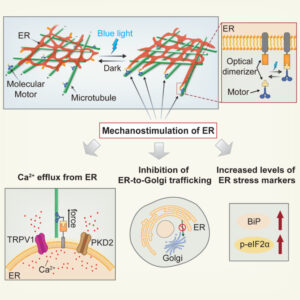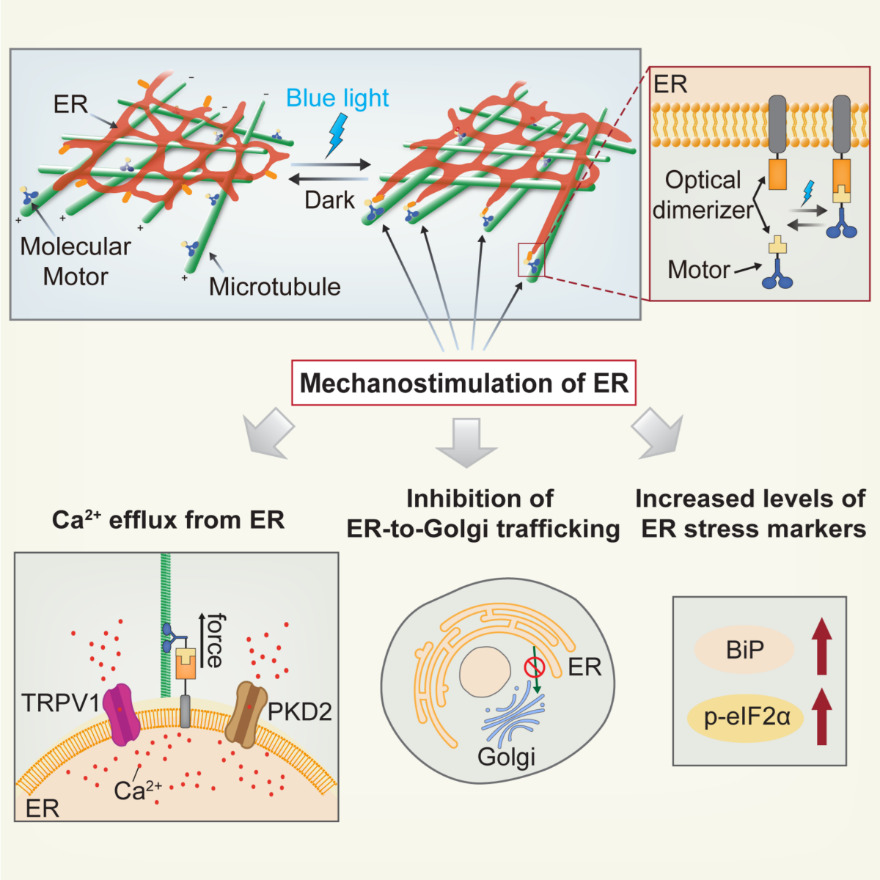CUHK
News Centre
CUHK develops new technology to reveal endoplasmic reticulum sensing of mechanical forces
Innovation enhances understanding of disease mechanisms and potential treatments
A research team led by Professor Duan Liting, Assistant Professor in the Department of Biomedical Engineering at The Chinese University of Hong Kong (CUHK), has developed the Light-Inducible Mechanostimulator (LIMER), the world’s first technology capable of precisely applying force stimulation to the endoplasmic reticulum (ER) of living cells. A groundbreaking new study demonstrates for the first time that the ER can sense mechanical stimuli, filling a gap in the field and significantly advancing the scientific understanding of the mechanisms of cellular force sensing and response. The findings are detailed in the cover article of the prestigious journal Developmental Cell.
Human body is constantly subjected to external forces. Our ability to hear sounds, touch objects and feel the presence of loved ones is due to the capacity of our cells to sense mechanical stimuli. Despite two decades of scientific research into how cells sense and respond to these forces, many questions remain. A key mystery lies in the role of the ER—a large, network-like organelle within cells—in mechanical sensing and response. Cells are complex structures composed of the cell membrane, cytoplasm, cytoskeleton, and various organelles. The ER is crucial for protein synthesis and transport, calcium ion storage and various cellular processes; however, excessive or prolonged stress can disrupt its function and contribute to diseases such as neurodegeneration and cancer. Due to its connections with the cell nucleus and cytoskeleton, applying force to the ER without affecting other cellular structures has posed significant challenges for researchers.
LIMER utilises light to direct the pulling forces generated by molecules called motor proteins within the cell to the ER, allowing for precise, non-invasive mechanical stimulation without disturbing other structures. This innovative approach enables real-time observation of the ER’s reactions, revealing for the first time that it can quickly respond to mechanical stimuli by releasing calcium ions within seconds. This calcium release is vital for cell signalling and regulation of cell function. Understanding how the ER manages calcium ion release may help uncover disease mechanisms and inform the development of new treatments.
Professor Duan said: “Dysregulation of cellular responses to mechanical stimuli is closely linked to various diseases. Our findings indicate that the ER is a crucial yet often overlooked element of the cellular response mechanism. By understanding its response to mechanical forces, we can potentially develop innovative targeted treatments by precisely regulate cell functions using mechanical methods.”
The article based on this research was co-first authored by PhD students Yutong Song, Zhihao Zhao and Linyu Xu in CUHK’s Department of Biomedical Engineering.
The full text of the research paper can be found at:
https://doi.org/10.1016/j.devcel.2024.03.014

Illustration scheme for the new tool, LIMER, and the ER mechanosensitivity it has revealed.
To achieve the unprecedented ability to exert forces on the network-shaped ER that spans the cell, LIMER uses light to direct the forces generated by motor proteins onto the ER.
By harnessing LIMER’s non-invasiveness, high specificity and reversibility, the study revealed the mechanosensing and mechanoresponding abilities of the ER.


